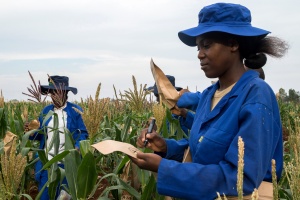Emergency UN meeting in Harare over armyworm outbreak
Africa |Author: AFP | February 14, 2017, Tuesday @ 09:12| 4042 views
Plant breeders pollinate male and female plants in a plot of a heat-tolerant hybrid maize growing at the Chiredzi Research Station, on October 24 2016. Under the scorching Zimbabwean sun, cattle seek shade among stunted thorn bushes in the drought-prone district of Zaka, where crops wither due to increasing temperatures and changing weather patterns. Severe lack of rain across southern Africa has hit the country hard, with government officials saying a quarter of the population faces starvation. Many villagers are forced to survive on wild fruit. (JEKESAI NJIKIZANA / AFP)
(AFP) - International experts hold emergency talks in Harare on Tuesday to tackle an outbreak of crop-eating "armyworm" caterpillars advancing across several African countries.
The armyworm has already caused damage to staple crops in Zambia, Zimbabwe, South Africa and Ghana, with reports also suggesting Malawi, Mozambique and Namibia are affected.
Experts say it appears to be the first time that the "fall armyworm" species from the Americas has caused widespread damage in Africa.
"So, farmers do not know really how to treat it," said David Phiri, the UN Food and Agriculture Organization's coordinator for southern Africa.
"Nobody seems to know how it reached Africa," he said, adding that it started in places like Nigeria and Togo, which had it last year.
One theory is that the caterpillars arrived in Africa on commercial flights from South America or in plants imported from the region.
The caterpillars eat maize, wheat, millet and rice -- key food sources in southern and eastern Africa, where many areas are already struggling with shortages after the most severe drought in recent years.
- 'Could be catastrophic' -
Experts from 13 countries will spend three days at the summit in the Zimbabwean capital forming a battle plan to defeat the pests.
The armyworm is "spreading rapidly" in Africa and could threaten farming worldwide, the Centre for Agriculture and Bioscience International (CABI) warned last week.
It said maize is particularly vulnerable to the larvae, which attack the crop's growing points and burrow into the cobs.
Unlike the native African armyworm, the fall armyworm does not "march" along the ground in huge numbers seeking more food, the FAO said.
"This sequence of outbreaks began in mid-December 2016 in Zambia," Kenneth Wilson, professor at Lancaster University in Britain, wrote in a briefing paper Monday.
"It is now as far south as South Africa. Because armyworms feed on many of the staple food crops they have the potential to create food shortages in the region."
The fall armyworm also attacks cotton, soybean, potato and tobacco fields.
Chemical pesticides can be effective, but fall armyworms have developed resistance in their native Americas.
"You use different methods. One of them is pesticides, another is to use biological control. Another is to use natural control, like digging trenches around the farm (or) natural predators, like birds, to eat those worms," said Phiri.
"If it is a small level of the worms, it's easy to control, using pesticides. Otherwise, it's very difficult to control it, so they will have to use different methods -- including sometimes burning the crops."
Zimbabwe's deputy agriculture minister Davis Marapira confirmed to AFP that the pest had been detected in all of the country's 10 provinces.
"The government is helping farmers with chemicals and spraying equipment," Marapira said.
The FAO, which is hosting the Harare meeting, said armyworm outbreaks combined with current locust problems "could be catastrophic" as southern Africa has yet to recover from droughts caused by the El Nino climate phenomenon.
In December, Zambia deployed its national air force to transport pesticides across the country so that fields could be sprayed.
© Agence France-Presse
Back
